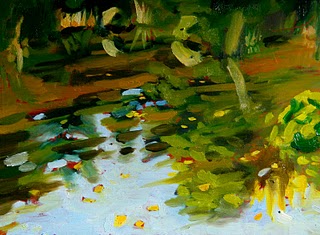Today I am starting a slightly longer painting, I plan to work on it for a few days and describe my process and thinking along the way. At 9 x 12 inches it's a little larger than my recent daily paintings, and the finished piece will be a bit more detailed than the dailies. When the painting is complete I'll post it for sale on eBay, in the meantime I'll just be posting the in-progress photos here.
The painting is a picture of several mandarins in a blue glass bowl, with peeled and sectioned fruit scattered in the foreground. To see the painting process in order read from the bottom up:
 Phase 4
Phase 4In this phase I start to correct my mistakes - you can see I've adjusted the size of fruit in the bowl, and made the bowl itself wider and more shallow, for example.
When the major design problems are solved I start adding more colors and refining the details. I use smaller brushes, and start to make some edges defined and more precise. I make sure the darkest darks and the lightest lights are represented, as well as clean, accurate swatches of the major colors. If I'm not careful the painting will get "muddy" as it progresses, so early on I try to establish the full range of values and accurate colors.
As I paint I'm always thinking about what I will do next, there are always problems I am not sure how I will solve. For example, the hanging cloth background has an embroidered pattern and I don't know yet how much detail and contrast to include. I'm also wondering how to show that the peel to the right of the bowl is partly obscured by the shadow. Also, I noticed that the blue bowl is not truly symmetrical and the ellipse of the rim is inaccurate. So I have my work cut out for me. Check back tomorrow and see how I do!
 Phase 3
Phase 3 This looks a lot more developed than the first step, but really I am just filling in some of the lighter tones and basic colors. Since I made most my drawing and composition decisions in the Raw Umber phase of the painting, this step is usually fast and satisfying. At this point I stop painting and spend time just looking back and forth between the painting and the still-life set up in front of me. I usually find I have made some errors I need to fix.
 Phase 2
Phase 2 For the first step of the oil painting I use just one color, Raw Umber, to sketch out the composition with loose, rough brushstrokes. As the painting progresses I usually realize I made some mistakes at this stage, so I try to keep the edges soft and blurry so it's easy to adjust any errors of proportion.
Phase 1
I start by preparing my wood panel with white artists' primer paint called "
gesso". When the
gesso is dry I paint a layer of acrylic paint in Burnt Umber to tone the panel. When the acrylic layer is dry I am ready to start oil painting. I usually prepare 5-10 panels this way at a time so when I am ready to start a painting I have several sizes on hand to chose from.
The reason I start with a colored background is because the initial colors and values I put down are more accurate than they would be on a stark white background.
I prefer wood artists' panels to canvas because the support is firm (there is no "give"), and the paint slides around easily on the smooth surface compared to the textured surface of a canvas.
 Wednesday, December 13, 2006 at 8:32PM
Wednesday, December 13, 2006 at 8:32PM 


































